Laser Safety Knowledge
1. What is laser?
A laser is a device that emits light (electromagnetic radiation) through a process of optical amplification based on the stimulated emission of photons. The term "laser" originated as an acronym for Light Amplification by Stimulated Emission of Radiation. The emitted laser light is notable for its high degree of spatial and temporal coherence, unattainable using other technologies.
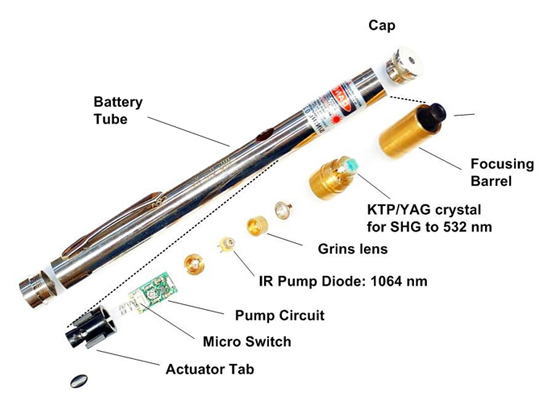
2. Laser Pointer Structure Chart
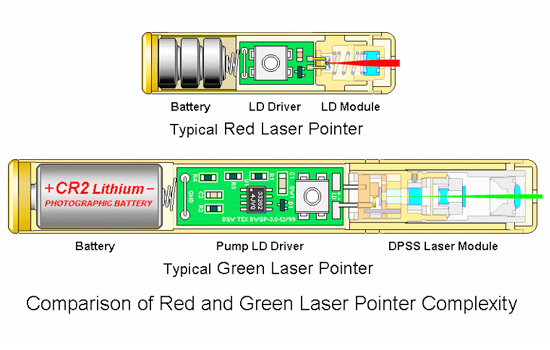
3. What is laser application?
Lasers have been got a wide variety of applications in daily life. Lasers is most applicable in presentation for pointing out objects, alignment at construction and project, medical treatment for cosmetic and surgical procedures. Lower power laser pointer is perfect for presentation, and astronomy stargazing. A higher power laser pointer up 100mW would be fine for burning experiment. A high power class IV laser is used for experiment, scientific research, military targeting etc.
4. What is wavelength?
Our eyes are sensitive to light which lies in a very small region of the electromagnetic spectrum labeled "visible light". This visible light corresponds to a wavelength range of 400 - 700 nanometers (nm) and a color range of violet through red. The human eye is not capable of "seeing" radiation with wavelengths outside the visible spectrum. The visible colors from shortest to longest wavelength are: violet, blue, green, yellow, orange, and red. Ultraviolet radiation has a shorter wavelength than the visible violet light. Infrared radiation has a longer wavelength than visible red light. The white light is a mixture of the colors of the visible spectrum. Black is a total absence of light.
Spectral colors and wavelengths

This chart shows colors of the visible light spectrum and the associated wavelengths in nanometers. Ranges are traditionally given as:
ultraviolet light, 100nm-400nm;
visible light, 400nm-750nm;
infrared light, 750 nm-1 mm.
5. What is laser transverse mode?
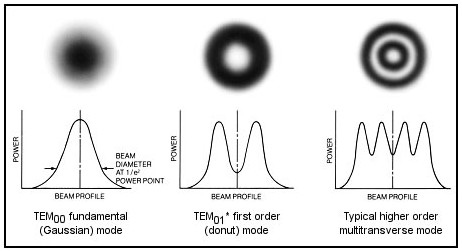
The transverse electromagnetic mode (TEM) structure of a laser beam describes the power distribution across the beam. Most laser applications require a fundamental mode beam (TEM00) with a Gaussian power distribution across the beam as shown to the right. This fundamental mode results in the smallest beam diameter and beam divergence and is capable of being focused to the smallest possible spot size.
Other applications profit from the increased power available in the first order mode (TEM01*) or even higher order modes. Laser output having a mode structure above the fundamental is commonly referred to as multitra nsverse mode (MTM). The mode structure produced by the laser can be changed simply by changing mirrors.
6. Different classification of lasers
Class I

Inherently safe; no possibility of eye damage. This can be either because of a low output power (in which case eye damage is impossible even after hours of exposure), or due to an enclosure preventing user access to the laser beam during normal operation, such as in CD players or laser printers.
Class II
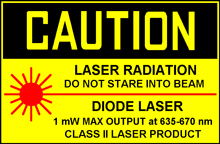
The blink reflex of the human eye (aversion response) will prevent eye damage, unless the person deliberately stares into the beam for an extended period. Output power may be up to 1 mW. This class includes only lasers that emit visible light. Most laser pointers and commerical laser scanners are in this category.
Class IIIa
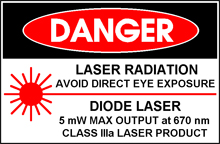
Lasers in this class are mostly dangerous in combination with optical instruments which change the beam diameter or power density, though even without optical instrument enhancement direct contact with the eye for over two minutes may cause serious damage to the retina. Output power does not exceed 5 mW. Beam power density may not exceed 2.5 mW/square cm if the device is not labeled with a "caution" warning label, otherwise a "danger" warning label is required. Many laser sights for firearms and laser pointers are in this category.
Class IIIb
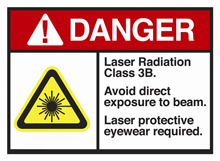
Lasers in this class may cause damage if the beam enters the eye directly. This generally applies to lasers powered from 5–500 mW. Lasers in this category can cause permanent eye damage with exposures of 1/100th of a second or less depending on the strength of the laser. A diffuse reflection is generally not hazardous but specular reflections can be just as dangerous as direct exposures. Protective eyewear is recommended when direct beam viewing of Class IIIb lasers may occur. Lasers at the high power end of this class may also present a fire hazard and can lightly burn skin.
Class IV
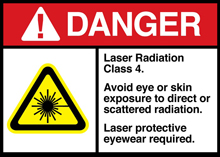
Lasers in this class have output powers of more than 500 mW in the beam and may cause severe, permanent damage to eye or skin without being magnified by optics of eye or instrumentation. Diffuse reflections of the laser beam can be hazardous to skin or eye within the Nominal Hazard Zone. Many industrial, scientific, military and medical lasers are in this category.
7. What is laser safety knowledge?
Even the first laser was recognized as being potentially dangerous. Theodore Maiman characterized the first laser as having a power of one "Gillette" as it could burn through one Gillette razor blade. Today, it is accepted that even low-power lasers with only a few milliwatts of output power can be hazardous to human eyesight, when the beam from such a laser hits the eye directly or after reflection from a shiny surface. At wavelengths which the cornea and the lens can focus well, the coherence and low divergence of laser light means that it can be focused by the eye into an extremely small spot on the retina, resulting in localized burning and permanent damage in seconds or even less time. Lasers are usually labeled with a safety class number, which identifies how dangerous the laser is:
• Class I/1 is inherently safe, usually because the light is contained in an enclosure, for example in CD players.
• Class II/2 is safe during normal use; the blink reflex of the eye will prevent damage. Usually up to 1 mW power, for example laser pointers.
• Class IIIa/3A lasers are usually up to 5 mW and involve a small risk of eye damage within the time of the blink reflex. Staring into such a beam for several seconds is likely to cause damage to a spot on the retina.
• Class IIIb/3B can cause immediate eye damage upon exposure.
• Class IV/4 lasers can burn skin, and in some cases, even scattered light can cause eye and/or skin damage. Many industrial and scientific lasers are in this class. The indicated powers are for visible-light, continuous-wave lasers. For pulsed lasers and invisible wavelengths, other power limits apply.
People working with class 3B and class 4 lasers can protect their eyes with safety goggles which are designed to absorb light of a particular wavelength.
Certain infrared lasers with wavelengths beyond about 1.4 micrometers are often referred to as being "eye-safe". This is because the intrinsic molecular vibrations of water molecules very strongly absorb light in this part of the spectrum, and thus a laser beam at these wavelengths is attenuated so completely as it passes through the eye's cornea that no light remains to be focused by the lens onto the retina. The label "eye-safe" can be misleading, however, as it only applies to relatively low power continuous wave beams; any high power or Q-switched laser at these wavelengths can burn the cornea, causing severe eye damage.
8. Laser Radiation Hazards
Laser pointers have got wide application from its first appearance. The lasers are mostly applicable as a tool for presentation in classroom teaching, astronomy stargazing, and meetings. However, these lasers are gradually owned by laser fans and enthusiasts including children due to the low cost and countless suppliers, and used in ways not intended by manufacturers. As a result, it is seriously important to understand the hazards of laser pointers before your real owning of a laser pointer.
Laser Hazards
Laser radiation predominantly causes injury by means of thermal effects. Even moderately powered lasers can cause injury to the eye. High power lasers can also burn the skin. Some lasers are so powerful that even the diffuse reflection from a surface can be hazardous to the eye.
Although there are potential dangers to retina, not all visible beam lasers are likely to cause permanent retina damage. The exposures to stare at the beam from a laser pointer are most likely cause afterimage, flash blindness and glare. A temporary hurt to retina will recover several minutes later.
The low divergence angle of laser light and the focusing mechanism of the eye mean that laser light can be concentrated into an extremely small spot on the retina. If the laser is sufficiently powerful, Permanent damage can occur within a fraction of a second, literally faster than the blink of an eye. Sufficiently powerful in the visible to near infrared laser radiation(400-1400nm) will penetrate the eyeball and may cause heating of the retina, whereas exposure to laser radiation with wavelengths less than 400nm and greater than 1400nm are largely absorbed by the cornea and lens, leading to the development of cataracts or burn injuries.
Infrared lasers are particularly hazardous, since the body's protective "blink reflex" response is triggered only by visible light. For example, some people exposed to high power Nd:YAG laser emitting invisible 1064nm radiation, may not feel pain or notice immediate damage to their eyesight. A pop or click noise emanating from the eyeball may be the only indication that retinal damage has occurred i.e. the retina was heated to over 100 °C resulting in localized explosive boiling accompanied by the immediate creation of a permanent blind spot.
Responsible laser owners should totally understand laser radiation hazards, and acknowledge the FAA regulations surrounding the use of laser pointers. Protective eyewear is typically required where direct viewing of a powerful beam may occur.
9. How to protect yourself from a laser danger?
It is quite important to taking effective methods to prevent damages from Class 3B or Class IIIb. Laser safety goggles are the main accessory for eye protection in the market nowadays. Different selection of laser units, eyewear must be selected for specific type to block the corresponding wavelength. For example, goggle absorbing 532nm typically has orange eyeglass.
Directly staring at laser pointers are strictly forbidden under any condition. Remember to wear safety goggle before using a laser pointer. Tips of laser pointer safety:
● Put the laser out of the reach of minors. Don't allow minors(under 18) to purchase and use a laser pointer under no supervision. Only adults are allowed to use laser pointers after they have understood the safety knowledge and risk of laser product.
● Be especially cautious whenever you are using a high power laser. You should never try to point your laser pointer to any human & animals, pilot of aircraft, and moving vehicles, or you will be jailed in prison for your misuse of laser units.
● Keep far away from high powered lasers. Please always keep yourself far away from high powered laser such as a burning laser. They are quite different from formal lasers for presentation. Never try to buy a laser without no identify of class and power.
10. How powerful a laser pointer will be?
Different applications need lasers with different output powers. Lasers that produce a continuous beam or a series of short pulses can be compared on the basis of their average power. Lasers that produce pulses can also be characterized based on the peak power of each pulse. The peak power of a pulsed laser is many orders of magnitude greater than its average power. The average output power is always less than the power consumed.
The continuous or average power required for some uses:
Power Use
1–5 mW Laser pointers
5 mW CD-ROM drive
5–10 mW DVD player or DVD-ROM drive
100 mW High-speed CD-RW burner
250 mW Consumer 16x DVD-R burner
400 mW burning through a jewel case including disk within 4 seconds
1 W Green laser in current Holographic Versatile Disc prototype development
1–20 W Output of the majority of commercially available solid-state lasers used for micro machining
30–100 W Typical sealed CO2 surgical lasers
100–3000 W Typical sealed CO2 lasers used in industrial laser cutting
5 kW Output power achieved by a 1 cm diode laser bar
100 kW Claimed output of a CO2 laser being developed by Northrop Grumman for military (weapon) applications
11. What's laser maintenance?
A correct maintenance of your laser will perfectly prolong its service life. We just need to follow the following tips:
What you need:
1. Microfiber Cloth
Please make sure the microfiber cloth is specifically designed for cleaning lenses. You can find this at your local camera or glasses store.
2. A Q-tip or tooth pick
You will need to fold the cloth over one of these in order to be able to reach the lens properly.
3. Lens cleaning solutions (Optional)
Use the lens cleaning solution only if the lens is not cleaned using the microfiber cloth alone. Please make sure the cleaning solution is designed specifically for lens cleaning.
*Warning: do not use water.
The procedure:
1. Wash your hand with soap and water. Make sure to dry them properly.
2. Fold the microfiber cloth over a toothpick or the handle part of a Q-tip. Make sure you do not touch the part of the cloth that will be cleaning the lens. You probably will not be able to fold the cloth twice, so you need to be very careful not to press too hard on the lens.
3. Gently move the cloth into the aperture until it comes in contact with the lens. Rub it from side to side but do not press too hard. Gently rotate the cloth in a twisting motion back and forth. Repeat this procedure until the lens of your laser is clean.
4. Turn your laser unit on to see if the lens is clean.
Still dirty? Try using lens cleaning solution.
Apply 1 drop only to the part of the cloth that will be cleaning the lens, the follow the same procedure as above. You will want to finish by using a dry part of the cloth to wipe the lens dry, this should take one pass side to side or gentle rotate.

